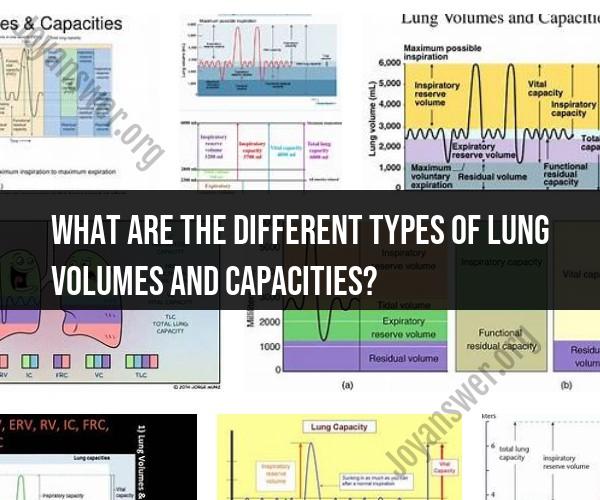What are the different types of lung volumes and capacities?
Lung Volumes:Lung volumes refer to the different amounts of air that can be present in the lungs at various points during the respiratory cycle. These volumes are measured using a device called a spirometer. Here are the key lung volumes:
Tidal Volume (TV): This is the volume of air that moves in and out of the lungs during a normal breath, without any extra effort. It's typically around 500 mL in adults.
Inspiratory Reserve Volume (IRV): This is the maximum volume of air that can be inhaled after a normal inhalation. It represents the additional air that can be forcibly inhaled beyond the tidal volume.
Expiratory Reserve Volume (ERV): This is the maximum volume of air that can be exhaled after a normal exhalation. It represents the additional air that can be forcibly exhaled beyond the tidal volume.
Residual Volume (RV): This is the volume of air that remains in the lungs even after a maximal exhalation. It's impossible to completely exhale the lungs, and the residual volume helps prevent lung collapse.
Lung Capacities:Lung capacities are combinations of different lung volumes and provide more comprehensive information about respiratory function. Here are the key lung capacities:
Vital Capacity (VC): This is the maximum amount of air a person can inhale after a maximal exhalation. It's the sum of tidal volume, inspiratory reserve volume, and expiratory reserve volume (VC = TV + IRV + ERV).
Functional Residual Capacity (FRC): This is the volume of air remaining in the lungs after a normal exhalation. It's the sum of expiratory reserve volume and residual volume (FRC = ERV + RV).
Total Lung Capacity (TLC): This is the total amount of air that the lungs can hold. It's the sum of all lung volumes, including residual volume (TLC = TV + IRV + ERV + RV).
Inspiratory Capacity (IC): This is the maximum volume of air that can be inhaled after a normal exhalation. It's the sum of tidal volume and inspiratory reserve volume (IC = TV + IRV).
Clinical Significance:Lung volumes and capacities provide valuable information about lung function and respiratory health. They are often used to diagnose lung diseases such as chronic obstructive pulmonary disease (COPD), asthma, and restrictive lung disorders. Changes in these values can indicate problems with lung mechanics and ventilation.
Remember that these values can vary based on factors such as age, sex, height, and physical condition. Interpretation of lung volumes and capacities should be done in consultation with medical professionals who can consider the individual's unique circumstances.






